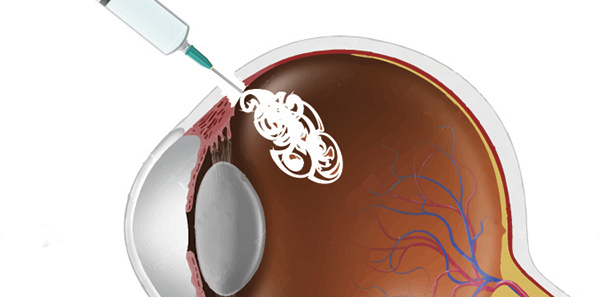1:30min

Image: N Bayat et al. Science Translational Medicine 2017
______________________________
By Philip Ritchie
Journalist
An international team of researchers has developed a temperature-responsive glue to seal eye wounds in an emergency.
Made by combining N-isopropylacrylamide copolymerised with butylacrylate, the glue acts as a liquid at low temperatures. When paired with the custom-designed syringe that controls temperature, the glue can be injected into the wound and mould to irregular shapes and contours.
As the glue is warmed by body temperature, it hardens and quickly forms a seal as strong as super glue. Once hardened, it can easily be adjusted or removed using cold water with no trauma to the eye.
The team created the glue as a faster, less-invasive and easier-to-use alternative to stitching, led by Niki Bayat, a chemical engineering PhD candidate from the University of Southern California.
‘This technology would afford the patient a larger window of time to complete surgical intervention without requiring specialty equipment such as surgical microscopes for implementation,’ the researchers write in a report of the study.

Image: N Bayat et al. Science Translational Medicine 2017
In a randomised trial the team tested the seal’s effectiveness, creating 3-millimetre lacerations on the sclera of rabbits’ eyes before injecting the glue. Within five minutes the seals hardened, and the team removed the convex parts of the glue.
A month of monitoring the effects showed the glue retained its shape for up to 30 days with no evidence of neurotoxicity, retinal detachment or significant ongoing inflammation. The eyes without the glue retained up to 30 per cent of their normal intraocular pressure; eyes injected with the glue retained 90 per cent of the normal intraocular pressure
The researchers admit some signs of acute inflammation appeared in the first 12 hours after injection, but within 24 hours, the glue was almost indistinguishable from the healthy parts of an eye. After 48 hours, the inflammation subsided for the rest of the month.
The team tested the glue further in two clinical workshops with ophthalmologists and military medics.
‘Each participant was given a brief tutorial and then asked to treat an enucleated pig eye with a full-thickness scleral laceration. Each participant was given two attempts to close the globe,’ the researchers write.
‘Forty-three percent of the participants were able to successfully deploy the hydrogel at the site to effectively occlude the ruptured globe on the first attempt. All of the participants were able to successfully deploy the hydrogel at the site of the injury and close the globe in two attempts.’
In a post-workshop survey, more than 80 per cent of users found the tool was easy to use and more than 90 per cent said the concept was feasible in real-life situations.
With the strength of super glue and its easy application process, the glue could improve patients’ health outcomes between accident and doctor visit, preventing visual side-effects such as cataract formation, maculopathy and discomfort.
The study was published in Science Translational Medicine.